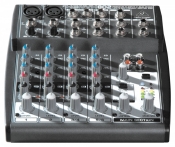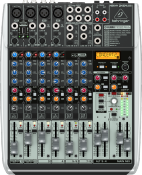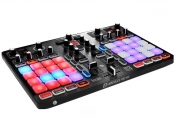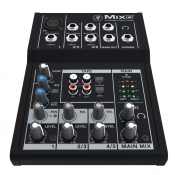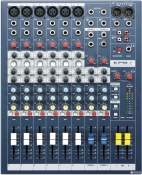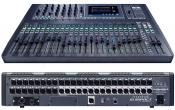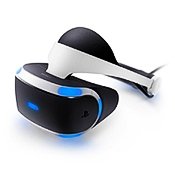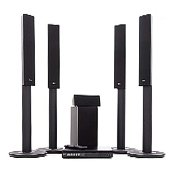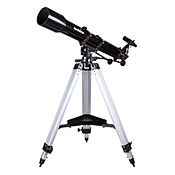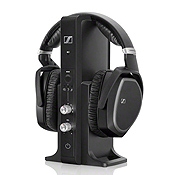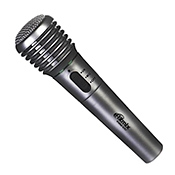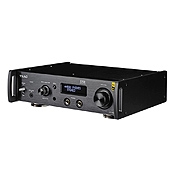Behringer XR18
Short review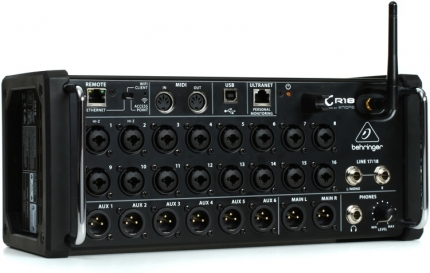
Buy Behringer XR18
Behringer XR18 Specifications
| The main | |
| Model name | BEHRINGER XR18 |
| Series | XR |
| Colour | the black |
| A type | digital mixing console |
| Number of channels | 18 |
| Mic preamps | 16 x XLR / TRS Combo |
| Line Inputs | 2 x TRS |
| Other inputs | MIDI |
| Outputs | 2 x XLR |
| Other outputs | 6 x XLR (Aux), 1 x MIDI |
| Headphone out | 1 x 1/4 "" |
| Data I / O | Ethernet, built-in Wi-Fi module |
| Tires / groups | 6 x XLR |
| Built-in effects | there is |
| Computer connection | 1 x USB |
| Channel assignment | there is |
| Equalization bands | 100-band Real Time Analyzer (RTA) |
| Rack mounting | Yes. |
Reviews about Behringer XR18
Lightweight, compact, does not make noise, has everything you need and a little in reserve.
It is inconvenient to copy scenes from device to device, incomplete description of functions in the instructions.
We were invited to work as a sound engineer in a cover group. Not long before that, the guys acquired this remote control, and together we began to master it. Wi-Fi control from an Apple tablet, via an external Asus router. We decided not to risk with the standard module, because we know from the forums that its power is low and with the current load of the range, the connection will be unstable. In general, there are 3 options for working: from the built-in Wi-Fi as an access point or router, or by wire directly or through a router.
So - the remote control itself is small, height 3 U (3 standard heights, a little more than 13 cm), width about 1/3 of the standard size (19 inches or 482 mm), the set includes "ears" for attaching the device to a rack or transport box. By weight ... I grabbed an empty box a couple of times, about 1 kg))
On the front panel, actually EVERYTHING: 16 universal (XLR-Jack) inputs, 2 auxiliary inputs on balanced (1/4 "TRS) jacks, 8 outputs (2 main and 6 auxiliary) on XLR connectors, a headphone jack, of course, too a large jack, in general, everything is according to a professional standard. The connectors at the top puzzled me a little: it's clear about RJ 45 for connecting a computer or router and MIDI input and output. About the ability to control from an external midi device, Beringer read on their website, in some cases a useful thing, but for the money it already makes sense to take the next model - X-32.But USB and Ultranet were forced to urgently dive into the instructions (by the way, not very informative and without Russian, but the latter does not upset). The USB connector allows you to record all channels separately , moreover, it is convenient to select the selection point (before or after processing) for each channel separately! And the ultra-net is even more convenient! It allows each musician to organize his own personal monitoring, and the musician will set up himself to himself, whom and how much it is convenient for him to hear. We have a small team, I handle it myself, but there are times when such a function will be very useful! In general, there are many different applications for Ultranet, and, as I understand, the limit is not soon.
The remote control is invisible in operation! That is, it does not emit any of its sounds, no hiss at "idle", or any other signs of its presence. Someone will say "Yes, he's digital!", But came across similar consoles that hiss quite loudly with the same settings ...
At each input, you can turn on phantom power (for condenser microphones), a high-cut filter with an adjustable cut-off point, and select the source: analog input or USB. You can combine a pair of channels in stereo (with the previous channel), there is a phase reversal of the signal. Also, at each input there is a gate (passes the signal only after it reaches a certain level), a compressor (limits the difference between the quietest and loudest sound, increasing the overall volume of the channel or limiting the maximum, you can choose!), Several expanders and t.etc., 5-band parametric equalizer, with the ability to select a mode for each band (cut HF or LF, shelf HF or LF, parametric, "vintage"), spectrum analyzer (analyzes the signal coming to the input), helps to catch a lot " start-up "microphone or understand which of the 6 microphones on the drum kit" helps "the neighboring one))).
Also, the signal from each channel can be sent to the main output, and to one (or all 6) auxiliary outputs (AUX), and to one (or all 4) sections of effects. The AUX signal from each input can be assigned pre- or post-fader, which makes life a lot easier too. After all this, it is already indecent to mention such trifles as a stereo panorama))) In general, you can take any signal from where you want it and send it where you want it, in any combination and direction.
I have already mentioned the effects - there are just a lot of them, as for me - even in excess. At the same time, however, you can only use 4, but if you think about it))) For now I use 3: two for vocals and accordion, one for drums (sometimes I tint the "hardware"). There are about a dozen of all kinds of reverbs in different designs, equalizers, compressors, and something exotic))) And just like with the main sources, you can also send it quite flexibly, although not like the main signals. By the way, there is also a 4-band parametric equalizer on the returns of the effects to the main output.
At the main output of equalizers 3: 6-band parametric (also, with a variable value of each band), or 1/3 octave (31 bands) graphic, or the same, but, as Beringer writes, "real", that is, improved, accurate. I use parametric as the most flexible and convenient. And play wherever it was not necessary)))). There is also a compressor, but I do not turn it on until I need it.
In general, if such wealth is presented in metal, then you will get a rack and not one, a kilogram per 100, hundreds of meters of wire in the form of a hellish spider web, and it will all cost like a wing from an airplane (even if you buy everything the cheapest). Assembling all this will take a couple of hours ... Yes, and without a remote control!
You can manage all this wealth from any software environment and in any way: from a tablet (there are programs for Mac, Vin and Android), on a PC the program simply runs from the installed folder, you don't even need to install it.
For each hall, composition, and so on, settings can be recorded and recalled as needed. In the Mac is created environment, you can create a show (for example, at a collective concert) and record snapshots (scenes) for each participant. There are only scenes in Vin.
Well, a small fly in the ointment: all scenes are stored in the tablet (computer or phone) from which they were created. In the instructions for the remote control, I did not find anything about copying scenes from device to device (at least within the same operating system), so if you lose the device, you can get stuck ...
Although I have long and firmly developed a wary attitude towards Beringer's products, digital consoles are a pleasant exception. I preferred them to more eminent manufacturers, because every ruble invested in a purchase is more than justified. Of course, I won't use such a "handless" version at an event that requires constant monitoring and quick response - after all, a mouse or tablet is not the fastest way to control, and blindly controlling the level of channels (and several at once) will not work. But for a cover band, such a remote control is the most suitable option!
